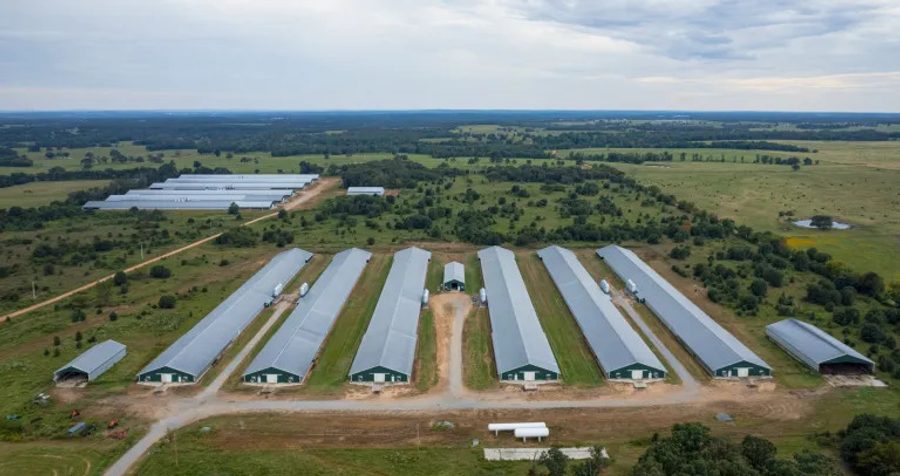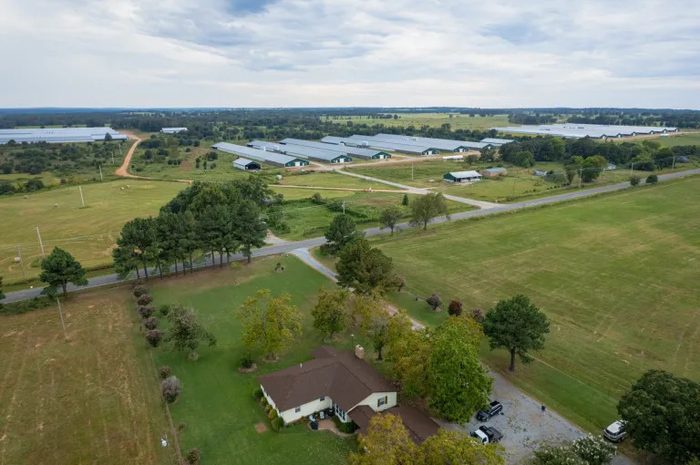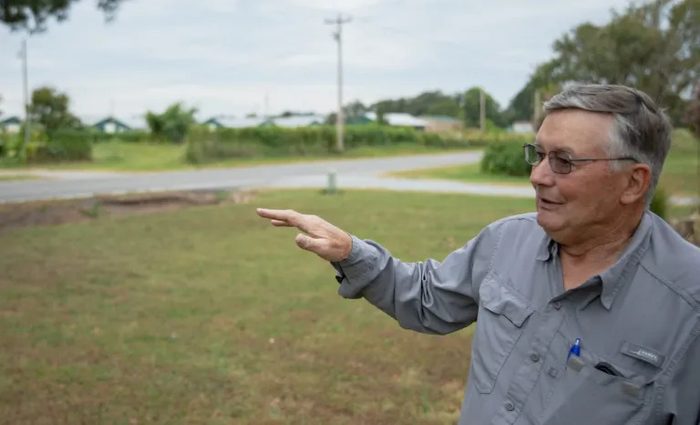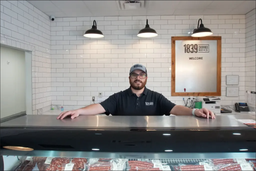How Deregulation Is Helping Turn Eastern Oklahoma into a Factory Farm Sacrifice Zone
Fetid air, polluted water, heavy truck traffic: Since the state loosened regulations a decade ago, a rush of industrial chicken farms is transforming life for rural residents.
Ben Felder

Editor’s Note: This story was originally published by Investigate Midwest.
As Barbara Dozhier prepared a ham before the arrival of her great-grandchildren and the rest of her family last Christmas Eve, she prayed for a weather forecast with wind out of the south. A breeze in the opposite direction meant her home four miles outside the east Oklahoma town of Kansas would be overcome with the stench of chicken litter.
Ever since a six-building poultry farm opened across the street in 2018 — where 336,000 birds are raised at a time — family gatherings at the Dozhier home have been forced inside.
“Sometimes the wind is out of the north and you just hurry up, get in the house and shut your door,” Dozhier said. “At first I was upset all the time but after all these years there is nothing you can do.”
Tim, Barbara’s husband of 59 years, developed a worsening cough when the poultry farm opened. He wears a mask when he mows the lawn and spends fewer hours in his backyard garden of okra, tomatoes, squash and other vegetables. The couple rarely eat on their back patio anymore.
“Since the farm came it has just been overwhelming, so overwhelming, that’s the only word I can really use,” Tim said from a recliner in his living room, where pictures of his family crowded a table behind him.
The poultry farm across the street from the Dozhier’s home — less than two and a half football fields away from their front door — would not have been allowed to be built if it were registered as a concentrated animal feeding operation, also called a CAFO. That designation aimed at industrial poultry farms raising more than 100,000 birds carries strict regulations for setbacks from homes and bodies of water, along with a requirement to notify neighbors before construction.
But Oklahoma gives numerous large industrial chicken farms an alternative registration process that doesn’t require notice to neighbors or as strict a setback requirement. Expanding poultry operations have used that alternative system to double the number of chickens raised in the state in recent years, ushering in a new wave of industrial poultry farms that many residents and environmental groups said is bringing with it increased traffic and pollution.
“If these farms were registered as CAFOs we wouldn’t be here,” said Matthew Alison, an attorney and partner with Indian & Environmental Law Group, who represents several residents and a nonprofit organization in lawsuits against the state over the rise in industrial poultry farms.
The state allows many large poultry farms to avoid a CAFO registration if their litter — a mix of chicken feces that can include wood and straw used in poultry bedding — is transported off the property. As long as the farm doesn’t store its litter on site, it can register as a poultry feeding operation, known as a PFO, which costs $10 a year and can be built as close as 500 feet to a nearby home.
Officials with the Oklahoma Department of Agriculture, Food and Forestry said a PFO still requires important setbacks from neighbors and pollution management plans.
But many residents said it is nowhere near the restrictions of a CAFO, which were intended to address large industrial farms.
“Right now, a PFO registration is just a paper exercise for the Oklahoma Department of Agriculture, Food and Forestry,” Alison said. “By letting these large farms register as PFOs the state is not providing the oversight that was intended with these large factory farms.”
Oklahoma poultry farms are mostly concentrated in the eastern part of the state, with many of the newest farms contracting with Simmons Foods. The Arkansas-based chicken producer built a $300 million processing facility in 2017, requiring new farms in the two-state region.
Residents living near the new poultry farms complain of offensive odors and debris, increased truck traffic, and contaminated well water systems. Environmental groups believe the litter from poultry farms has polluted area creeks and lakes after being sold as fertilizer to many area crop farms.
A nonprofit organization called the Spring Creek Coalition — one of Alison’s clients — began monitoring pollution levels in 2020 in Spring Creek, which flows 34 miles through Delaware, Cherokee and Mayes counties, an area of the state with a high concentration of large industrial poultry farms. Its monitoring found increased levels of phosphorus, nitrogen and E. coli in recent years. Levels of enterococcus, which indicates the presence of pathogens from animal feces, have also been found to be as much as 36 times higher than the state standard of 61 colonies per 100 milliliters set by the Oklahoma Water Resources Board.
Too much phosphorus can create algae that consumes oxygen and blocks sunlight from reaching underwater plants.
“The rocks in the creek are all slippery and coated with algae, and they never were before,” said Beth Rooney, a member of the Spring Creek Coalition since 2009, who said many of the dark-colored rocks along the bottom of the creek were white just a few years ago.
However, the state agencies overseeing permits for industrial farms and water claim they don’t have the authority to deny new poultry operations or increase standards without legislative approval.
Residents also often have no way of knowing a new farm is coming until construction is underway.
And state lawmakers have taken steps to make protesting new chicken farms more difficult.
While some residents and organizations have turned to lawsuits, most like Tim and Barbara Dozhier say they lack the financial resources to sue the state or a large corporation.
“One of my neighbors said I ought to pray for a tornado to rip those (chicken barns) up out of the ground, but I can’t do that,” Tim said. “Two wrongs don’t make a right and the people taking care of that farm are just trying to work to support their family.
“But I would like to take a load of this chicken poop to Simmons and dump it in their front yard and let them breathe and smell that for a week or two. There was no consideration for the people who live around here.”
EPA counts fewer CAFOs in Oklahoma despite rapid growth of industrial poultry farms
In 2012, Oklahoma was home to 626 CAFOs, the 10th highest number of any state in the nation, according to records from the Environmental Protection Agency. For decades, Oklahoma had seen a steady rise in factory farms, including large hog operations mostly in the west and poultry farms in the east.
Arkansas-based chicken producers like Tyson Foods contracted with Oklahoma farmers to raise millions of birds each year, shipping thousands of young chickens at a time to farms to be raised for several weeks before being sent back for processing.
Most chickens are raised inside long steel buildings that disperse feed, control temperature and collect waste. Farmers are constantly seeking more cost-efficient ways to raise chickens to 5 or 6 pounds, knowing that a swing of even a few cents per pound paid by a company like Simmons Foods can be the difference between making ends meet or going bankrupt.
The growth of industrial chicken farms in the 1990s and 2000s drew complaints that key water systems in eastern Oklahoma were being polluted by poultry litter.
The EPA monitors CAFO permits under the Clean Water Act. But states are allowed to take on that authority if their governor makes a formal request and the EPA determines the state can meet the Act’s requirements.
Oklahoma made a formal request in 2012 and was granted authority the following year. Then EPA Regional Administrator Ron Curry said the move would “benefit … both the business community and the people of Oklahoma.”
Jim Reese, Oklahoma’s agriculture secretary at the time, said the move would give Oklahoma more control over its own resources and a better handle on pollution.
“We plan to continue to exceed expectations in protecting our natural resources in Oklahoma,” Reese said at the time.
One year after taking over the CAFO registration process, Oklahoma reported a 91% decline in the number of factory farms. For the past decade, most poultry farms have registered under the less restrictive poultry feeding operation, while the number of birds licensed to be raised in Oklahoma at any given time doubled to more than 60 million. (More than 215 million total chickens were raised in Oklahoma in 2022 for consumption.)
Lee Benson, a spokesperson for the Oklahoma Department of Agriculture, Food and Forestry, said the drop in CAFOs was because Oklahoma officials “corrected” the EPA’s count.
“That (2012) number was a misunderstanding because not all of those (farms) should have been required to get a federal (CAFO) permit,” Benson said during a recent interview. “EPA accepted our position on that and then updated that number to reflect the federal CAFO permits in Oklahoma, that’s why that number changed so drastically.”
Today, 543 Oklahoma farms are registered as poultry feeding operations, a third of which have more than 100,000 birds, even though the EPA reports only 39 CAFOs of all animal operations across the state.
Benson also said the agency believes the PFO is in some ways more restrictive than a CAFO and allows the state to address the unique needs of a poultry operation, compared to cattle or hogs.
“You can’t compare the CAFO setbacks to a PFO because it is a different operation based on the waste, according to the act,” Benson said.
A PFO restricts a poultry farm from being within 500 feet of a home, and while CAFOs don’t have the same setback requirement, they are not allowed to be within one mile of 10 or more “occupied residences,” according to the state’s CAFO act.
However, in 2021, an agency official acknowledged that CAFOs were in many ways more restrictive.
While being deposed for a lawsuit the Spring Creek Coalition had filed against the Department of Agriculture over its permitting process, Tenna Gunter, the agency’s general counsel, called a CAFO license a “more advanced license” than a PFO.
She confirmed that a CAFO was only required if the poultry litter remained on the property of the farm in some type of lagoon or was discharged into a nearby body of water. She also acknowledged that many of the farms Oklahoma registers as PFOs would be considered a CAFO by the federal government.
“Oklahoma’s definition (of a CAFO) is different,” Gunter said during her deposition, according to a transcript.
A CAFO permit also requires that a future poultry operation notify its immediate neighbors before construction, giving them a chance to appeal the application.
When Simmons Foods expanded its production capacity in 2017 with a new facility in northwest Arkansas, Oklahoma became a desirable location for new poultry farms due in part to the state’s lower land prices.
Oklahoma’s PFO permit also gave farmers and producers a chance to locate large barns closer to homes without having to notify neighbors.
Simmons Foods did not respond to an email and phone call requesting comment.

Residents, federal judge say state has done little to protect against poultry farm growth
Louanna Cochran didn’t know about the poultry farm planned for across the street from her northeast Oklahoma home until construction was underway on six long buildings that would together raise more than 300,000 birds at a time.
The owners of the farm contracted with Simmons Foods and registered as a poultry feeding operation in 2017.
At least 62 chicken farm buildings are located within two miles of Cochran’s property, a common feature of the rolling hill landscape. But the closest farm is about 500 feet from her front door.
The farm transports its litter offsite, allowing it to avoid the CAFO permit. Cochran was still worried about pollution in her water well, especially since she said the rainwater flowing from the nearby farm into her yard often “smells poopy.”
In 2019, Cochran, a citizen of the Cherokee Nation, asked her tribe’s Office of Environmental Health to conduct a test, which found high enough rates of coliform bacteria — sometimes caused by poultry litter — that it was recommended she disinfect her well.
The water test, a copy of which was obtained by Investigate Midwest, also reported a turbidity rate — how cloudy water appears — at 15.3 nephelometric turbidity units, well above EPA’s recommended rate of 1 or below for drinking water. (It’s common for well water systems to see a rate closer to 4 NTUs.)
While the Oklahoma Department of Agriculture, Food and Forestry oversees the PFO permit, the Oklahoma Water Resources Board granted a temporary water use permit to the new poultry farm across the street from Cochran’s home. In 2018, Cochran filed a lawsuit against the state water agency, claiming it would be wrong to issue a permanent water use permit without determining whether the new farm would cause pollution or significantly deplete the underground aquifer.
The state needed to do more to protect residents and waterways, Cochran said.
Earlier this year, a Delaware County judge ruled in Cochran’s favor and said the Oklahoma Water Resources Board must consider water quality and quantity when issuing permits. Weeks after the judge’s decision, the nine-member board heard from attorneys for Cochran and the chicken farmers.
“We haul our (chicken) litter away,” Blaine Nice, an attorney representing the farm nearest to Cochran’s home, told the Oklahoma Water Resources Board (OWRB) during an Aug. 15 hearing, reminding them the poultry farm is not considered a CAFO by the state. “My poor clients have lived (with) this case for six years now.”
Nice did not respond to a request for comment.
The OWRB reissued the water use permit, which Alison, Cochran’s attorney, said didn’t seem to take the judge’s order into serious consideration.
In a separate lawsuit against the Oklahoma Department of Agriculture, Food and Forestry, the nonprofit Spring Creek Coalition argued the state should require CAFO permits for more large poultry farms. (A hearing in the case is scheduled for later this month in a Delaware County court.)
The agency has repeatedly said a CAFO permit is not required as long as a farm’s poultry litter is taken off site, which officials said addresses the biggest pollution problem of industrial chicken farms.
Eli Holmes, senior counsel with the Socially Responsible Agriculture Project, a Delaware-based nonprofit that advocates against the harms of industrial farming, said removing litter from an industrial chicken farm doesn’t solve all the issues a CAFO permit was designed to address.
“The problem is just being moved away but it still has to go somewhere,” Holmes said.
Even though the litter eventually may be removed, it can still seep into groundwater systems or flow into neighboring properties.
“This is such a pervasive problem now that we’re talking about people’s drinking water being contaminated, we are talking about air pollution from improper storage of waste,” Holmes said. “There’s just a lot of regular public health effects and environmental effects that we’re seeing from this.”
Both the Oklahoma Department of Agriculture, Food and Forestry and the Oklahoma Water Resources Board have claimed their hands are tied without action by the state legislature.
“We follow what the legislature gives us authority to do,” said Benson, the spokesperson for the Oklahoma Department of Agriculture, Food and Forestry.
However, the state’s Concentrated Animal Feeding Operations Act states “the State Board of Agriculture may make a case-by-case designation of concentrated animal feeding operations” and can consider a farm a CAFO if it believes it is “a significant contributor of pollution to the waters of the state.”
Benson said the Oklahoma Department of Agriculture, Food and Forestry regulates poultry farms and has the power to close any animal farms that do not adhere to state law.

Lawmakers passed law that could make protests against farms more difficult
The rumble of large diesel trucks has become a constant sound at Clayton Williams’ Delaware County home, which is across the street from a large poultry farm along Highway 412.
There’s the sound of trucks bringing young chicks to the farm and picking them up several weeks later. Trucks also drive by transporting waste from the dozens of poultry farms within a mile of his home. The loudest sound is the conveyor belt machine used to collect chickens ready to be processed.
“I almost went over there to say something because that machine was so loud,” Williams said. “It really changes your quality of life, people don’t understand that.”
Beyond the sound of trucks, the Williams home has also been overcome with foul smells, feathers and flies, some of which landed on his shoulder as he walked through his front yard.
“We never open our windows anymore, you just can’t,” said Beth, Clayton’s wife, who said she developed a persistent cough when the poultry farm opened in 2019.
Beth and Clayton said they were frustrated with companies like Simmons Foods, but also state officials, who they believe have ignored the problem. A federal judge recently seemed to agree.
In 2005, then Oklahoma Attorney General Drew Edmondson filed a lawsuit against several chicken producers — including Tyson Foods and Simmons Foods — alleging they were responsible for increased pollution in the Illinois River Watershed region in eastern Oklahoma.
The lawsuit meandered through the court system for nearly two decades before a federal judge ruled this year that litter on poultry farms or litter removed and used for fertilizer on nearby crop farms was to blame for elevated levels of phosphorus in nearby rivers, streams and lakes. The pollution depleted aesthetics, decreased the oxygen supply in water — a deterrent to fish and other aquatic habitats — and required cities and towns that use the water to spend more on treatments or seek other water sources, the state claimed.
In mandating that the poultry companies work with the state to develop a settlement agreement— a process currently underway with a mediator—U.S. District Judge Gregory Frizzell also remarked that the state had not addressed water quality issues with higher standards.
“Neither the legislature, nor (the Oklahoma Department of Agriculture, Food and Forestry), nor any other state agency has formally advocated for the adoption of more stringent standards to limit or prohibit the land application of poultry litter to the Oklahoma (Illinois River Watershed),” Frizzell wrote in his decision in January.
Not only has the state not adjusted water standards associated with chicken farms, but lawmakers have tried to make it harder for residents to object to poultry operations.
Earlier this year, Oklahoma’s Republican-majority Legislature and governor passed House Bill 2053, which would dismiss a protest against a water use permit for a farm if the protest is “based solely on the industry or entity applying to use the water.”
State Sen. Brent Howard, the bill’s author, said the legislation aimed to stop protests from people who are against large industrial chicken farms.
“Whenever there is an application for a groundwater permit we are trying to make sure people aren’t solely objecting to the permit to put a specific industry out of place,” Howard said during a legislative hearing this year.
Barbara Dozhier, whose house is across the street from a large poultry farm, said she isn’t against the poultry industry as a whole. Although her experience has turned her entirely off eating chicken.
“It used to be one of my favorites,” Dozhier said. “But I just don’t care for it anymore.”
Investigate Midwest is an independent, nonprofit newsroom. Our mission is to serve the public interest by exposing dangerous and costly practices of influential agricultural corporations and institutions through in-depth and data-driven investigative journalism.Visit us online at www.investigatemidwest.org
Sourcing & Methodology Statement:
Interviews
Tim and Barbara Dozhier, Sept. 11, 2023 and Sept. 21, 2023
Matthew Alison, Aug. 11, Aug. 22, and Aug. 30, 2023
Beth Rooney, Aug. 31, 2023, and Sept. 11, 2023.
Lee Benson, Sept. 15, 2023, Sept. 21, 2023 and Sept. 25, 2023
Eli Holmes, Sept. 5, 2023 and Sept. 29, 2023
Beth and Clayton Williams, Sept. 11, 2023
Reports and Documents
Oklahoma Concentrated Animal Feeding Operations Act, Oklahoma statute
Oklahoma Registered Poultry Feeding Operations Act, Oklahoma statute
Spring Creek water testing results, Spring Creek Coalition
Spring Creek Coalition v. The Oklahoma Department of Agriculture, Food and Forestry, 2021 lawsuit in Oklahoma district court
Cherokee Nation water well test for Louanna Cochran, Sept. 3, 2019
Oklahoma Water Resources Board Aug. 2023 meeting packet
Louanna Cochran and others v. the Oklahoma Water Resources Board, 2019 lawsuit in Oklahoma district court
U.S. District Judge Gregory Frizzell 2023 decision in Oklahoma Illinois River Watershed case
House Bill 2053, Oklahoma state Legislature 2023
Data
ODAFF Fiscal Year 2019 Total Birds and Houses by County
Number of Concentrated Animal Feeding Operations in Oklahoma in 2012, 2013 and 2022, Environmental Protection Agency
Ben Felder covers agribusiness and the meat industry in Oklahoma for Investigate Midwest. Felder previously worked for The Oklahoman as a political enterprise reporter blending narrative storytelling, data analysis and investigative reporting to cover the state’s political leaders, the influences behind them, and their impact on everyday Oklahomans. Originally from Kansas City, Missouri, and a graduate of Trevecca University in Nashville, Felder lives in Oklahoma City with his wife, Lori, and son, Satchel.





